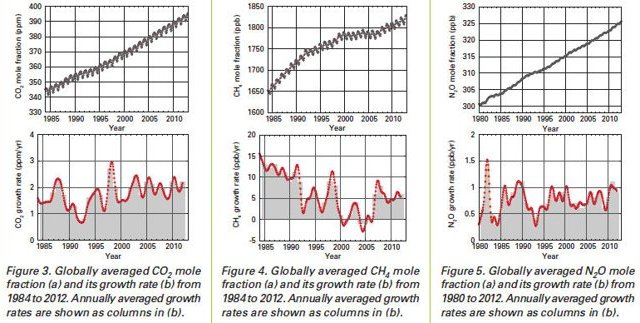Nitrous Oxide (N2O)
Nitrous oxide is emitted into the atmosphere from both natural (about 60%) and anthropogenic sources (approximately 40%), including oceans, soil, biomass burning, fertilizer use, and various industrial processes. Its atmospheric concentration in 2012 was about 325.1 parts per billion, which is 0.9 parts per billion above the previous year and 120% of the pre-industrial level. Its impact on climate, over a 100-year period, is 298 times greater than equal emissions of carbon dioxide. It also plays an important role in the destruction of the stratospheric ozone layer, which protects us from the harmful ultraviolet rays of the sun.
Other Greenhouse Gases
The total radiative forcing by all long-lived greenhouse gases in 2012 corresponds to equivalent CO2 concentration of 475.6 parts per million, compared to 473.0 parts per million in 2011. Other long-lived greenhouse gases include ozone-depleting chlorofluorocarbons (CFCs), as well as hydrochlorofluorocarbons (HCFCs) and hydrofluorocarbons (HFCs), which are increasing at relatively rapid rates.
Check the following link to read/download the 2013 Greenhouse Gas Bulletin:
http://www.wmo.int/pages/prog/arep/gaw/ghg/GHGbulletin.html
Source: WMO.
Notes:
The WMO Global Atmosphere Watch Programme (www.wmo.int/gaw) coordinates systematic observations and analysis of greenhouse gases and other trace species. Fifty countries contributed data for the Greenhouse Gas Bulletin. Measurement data are reported by participating countries and archived and distributed by the World Data Centre for Greenhouse Gases (WDCGG) at the Japan Meteorological Agency.


















